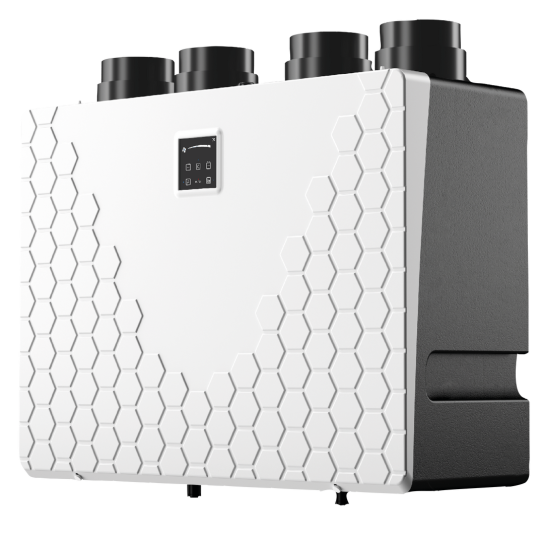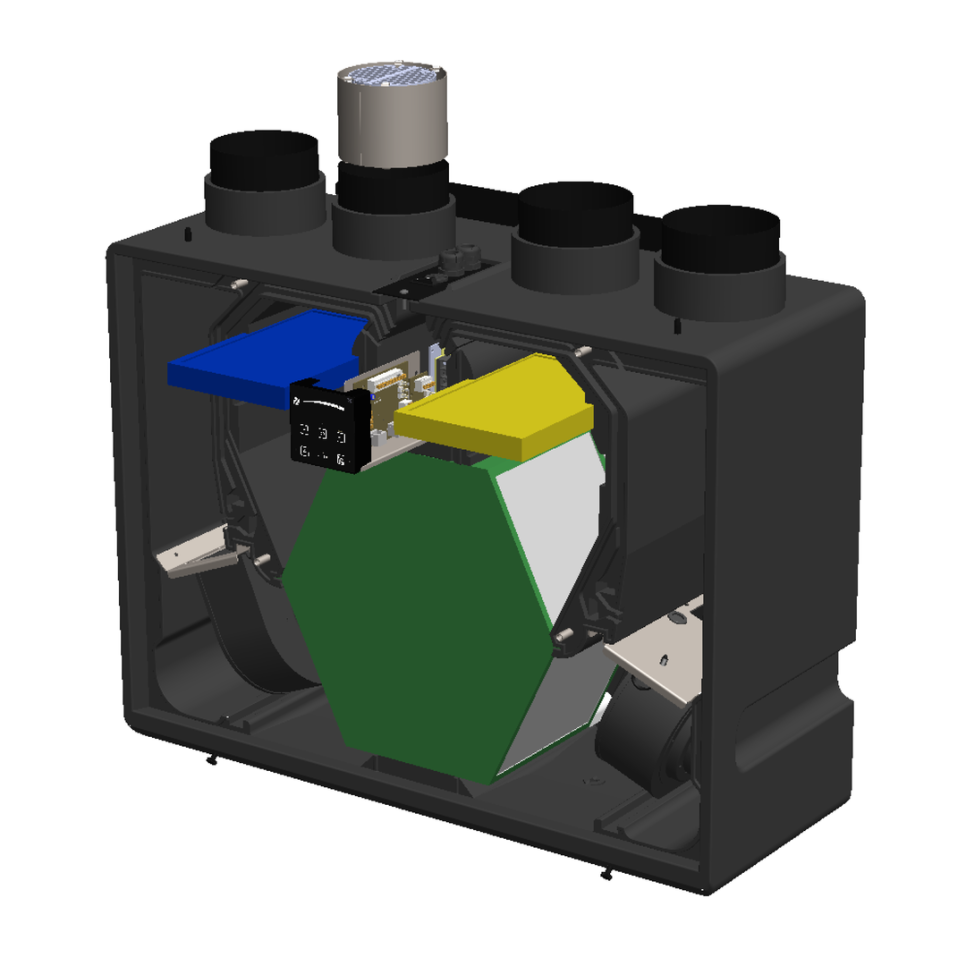...we focused on maximum utility value du-
ring the development of the Xhouse heat re
covery unit. It is suitable for apartments and
family houses. The unit adapts to your needs
if you solve controlled replacement of the air
or too high inside humidity. Thus you will feel
better in your home.
The unit excels in low weight (only 16kg)
The energy class of the unit is A. The unit thus
complies with most subsidy programs.
Possibility of CO2 and RH sensor connection.
The controls offers the possibility of extension to remote control and connection to your smart home platform.
Possibility of electronic bypass or mechanical bypass.
Possibility of connecting external heating (up to 1 kW). The unit supplies power to the heater only when it is running. Post-cooling function after switching off the unit (3min)

Low weight (16 kg)
Compact dimensions (depth 300mm)
Easy installation
High disposition pressure
If you are currently building, the solution of central ventilation is an almost clear choice for you. However, it is necessary to think about this technology already during the project. For ventilation and supply of fresh air to the whole house or more rooms, it is more appropriate to use central air recuperation, which also prevents the formation of moisture and consequently the ailments associated with it. Thanks to the high-quality insulation of the buildings, the natural ventilation caused by the leaks was minimized. This increases CO2 concentrations and the need to ensure a regular supply of fresh air. The Xhouse heat recovery unit offers you one of the best solutions.

Decentral ventilation is mechanical ventilation for one room only. Central ventilation is mechanical ventilation of more rooms by once device. Central ventilation is provided by units with bigger dimensions than units for decentral ventilation, since these has to supply higher air volume. Units for central ventilations are usually located in the technical room where they are not annoying the users by high noise level and they are not blocking any space. Central ventilation systems require ducting for supply and extract air, which are often difficult to place in the way to do not disturb. Central ducting systems require cleaning every year, which is complicated. Cost investment of the installation of ducting and theirs covers are usually in the same level as the purchase price of the ventilation unit. Another aspect is regulation and controlling of these systems in order to achieve minimum operation costs and distribution of the air to there where is needed. The advantage is, that suction and exhaust does not have to be located on the outside wall and if so, there are always only two openings. Decentral units are used for ventilation of one room only. Theirs dimensions vary from very small ones located in to the wall, to bigger ones with dimensions similar to smaller radiator. These units ventilate only selected rooms and when needed. Theirs advantage is, that these units can be operated according to sensors of quality of the air (Air Quality sensors -AQS), typically by CO2 sensor or relative humidity sensor. Thanks to the sensors the unit ventilates only when the concentration of pollution in the air is above set level – this means “ON DEMAND”. This ensure, that the energy consumption during ventilation is at minimum level, about 35% lower than ventilation without sensors. More powerful units can supply in to the room bigger air volume of the air in case of need than central units and thus can ventilate the room faster and better.
It is necessary to consider more suitable solution for each specific project.
One of the mains parameters of the unit is the air volume which is the unit able to supply in to the room. Value which is usually used for choice, is quantity of the air at one square meter of the floor space. Manufactures usually used 25m3/h at 20m2. This is half quantity which ensure healthy climate. For the most cases are better to use quantity of the air need at quantity of the people inside the room. Typical value is 25m3/h/person.
It is important to choose higher value of both methods in specific case anyway.
Sensors enable automatic operation of the unit. The unit operates only, when the inside quality of the air is worse than requested. When fulfilling the air quality request, such a solution generate only minimum ventilation costs in the real operations! This also means lower operation costs and faster paid back of the investment to ventilation unit purchase. Xroom enables connection of CO2 sensor, RH sensor and radon sensor.
It is important to consider, if the more important are operation costs, or purchase investment.
Enthalpic regeneration (ERV) means backwards gaining of the moisture from the extract air. The supplied air is so dry in the winter, that it can reduce the indoor relative humidity in the air below 20%. Such a low relative humidity cause drying-off the skin, mucous membrane and wood- -made furniture and floors. Dry mucous membrane makes breathing less comfortable and cause respiratory diseases. Dehydration of the skin makes wrinkles and the drying-off the wood can damage furniture or floors. Ideal relative humidity inside should be around 50%. The solution is usage of Enthalpic Recovery Exchanger (Xvent recommends).
It is important to know that enthalpy heat exchangers always also recover heat.
Ventilation by windows is in many cases enough (residential areas, alone houses close to the forest), but does not ensure the energy savings (heat in the winter, cold during summer). But if there is noise outside, pollen, annoying smell or freezing conditions, the ventilation by window is not the best solution. Even thought in the summer, if the room is equipped by air conditioner, is the opening the windows not suitable. In all cases mentioned above is the mechanical ventilation senseful solution.
If the unit is equipped by heat recovery and/or moisture regeneration, the energy savings reach 85%, which will have to be supplied by heating or by cooling device otherwise.
It is important to consider if the priority is price or health.
thanks to the EC fans 1 EUR/month when considering average usage four hours a day every day.
Costs of filter replacement are around 10 EUR/month when replaced twice a year.